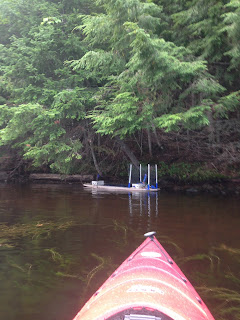The next morning turned out to be grey and overcast, so AMOS didn't have much charge when it woke up at 9:00 am. It traveled for about 3.5 km though, before it went into sleep mode to recharge its batteries. This time however, AMOS drifted onto the south river bank, where there was an exceptionally steep hill, very thick with trees that very nicely shaded the robot from the sun. It was hardly charging at all, so again I went out that evening to fetch it back, again in the rain, and this time with a bit of thunder and lightening as well. Here is a pic of where it was hiding, nicely shaded under some trees:
We were scheduled to leave for a family vacation on the weekend, so I brought AMOS back home after that, did some more minor debugging, and set it up in the backyard to test out the solar charging, sleep mode, and battery management software while we were away. These tests have mostly gone OK, with only some minor software issues that have been fixed. The biggest problem that these and the actual field tests of last week have confirmed is how to make sure that AMOS gets enough sun to properly re-charge itself. Basically AMOS needs to drive itself out into a place where there is known to be sun shining, then shut itself off (including GPS) to conserve power, and hope that it doesn't blow too far away. Right now if it needs to re-charge in the daytime, it is set to go back into sleep mode for an hour. Probably this should only be 10 minutes though, so that it can check to see if it has drifted too far away, and quickly correct its position if necessary, before going back into sleep mode to re-charge. Finding enough sun is going to be a bit of a challenge, all the more so now that summer is coming to an end.


No comments:
Post a Comment